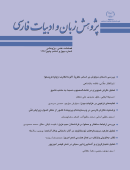بررسی داستان سیاوش بر اساس نظریة «آلودهانگاری» ژولیا کریستوا
محورهای موضوعی : Research in Iranian classical literatureذوالفقار علامی 1 , فاطمه باباشاهی 2
1 - دانشگاه الزهرا
2 - دانشگاه الزهرا
کلید واژه: شاهنامه داستان سیاوش کریستوا نظریة آلودهانگاری,
چکیده مقاله :
داستان سیاوش از جمله داستانهای تراژیک شاهنامه است که افزون بر قابلیتها و ظرفیتهای گوناگونی که برای نقد و بررسی دارد، برخی از پیامهای اصلی حماسة ملی و اسطورههای ایرانی مانند: نبرد میان خیر و شر، ایران و انیران، مبارزه با پلیدیها و پلشتیهای روح انسانی و... در آن جریان دارد. یکی از نظریههایی که با نگاه روانکاوانه به تحلیل آثار ادبی میپردازد و برای تحلیل این داستان مناسب به نظر میرسد، نظریة آلودهانگاری ژولیا کریستوا از منتقدان پساساختارگراست که بر اساس آن شاعر یا نویسنده، پلیدیها و پلشتیهای روح انسانی را از طریق متن برونفکنی میکند. ماجرای عشق آلودة سودابه، گذر سیاوش ازآتش برای اثبات بیگناهی و مرگ اندوهبار او در توران زمین، از نمودهای آشکار و آلودهانگارانه این داستان است که زمینه را برای استفاده از این رویکرد فراهم میسازد. از این رو، این مقاله در صدد است با توجه به وجود رانهها و افزونههای آلوده در این داستان که در جریان عشق سودابه، در نهایت با همراهی عواملی دیگر مرگ اندوهبار او را رقم میزند، آن را تحلیل کند و به این پرسش پاسخ دهد که کاربرد این نظریه تا چه اندازه در این داستان مؤثر و کارآمد است؟ و با کاربست این نظریه، آیا به تحلیلی تازه میتوان دست یافت یا خیر؟ برآیند مطالعه نشان میدهد: این بررسی با تبیین نظریة آلودهانگاری کریستوا و تحلیل داستان سیاوش از این منظر، سازگاری دارد و امکان خوانشی نوین از آن و به تبع آن قضاوتی دیگرگون از فردوسی، سراینده داستان را، برای خوانندگان فراهم میسازد.
The story of Siavash is one of the most tragic stories of Shahnameh which has a great potential to be studied in different ways. Furthermore, it contains some of the principal messages regarding national epic and Iranian myths, like the battle between good and evil, Iran and Aniran, fighting the dirt and filth in human soul, and etc. One of the theories that has a psychological approach to the analysis of literary works, and seems appropriate for analyzing this story is the theory of Abjection introduced by Julia Kristeva, a post-structuralist critique, based on this theory, the poet or writer projects the filth and dirt in human souls through the text. The story of Sudabeh’s sinful love, Siavash passing through fire to prove his innocence, and his tragic death in Touran are some of the obvious aspects of the story that makes the theory of abjection appropriate for the analysis of this story. Therefore, in this article, the story is analyzed focusing on the such elements of the story like Sudabeh’s love, and other events that led to his tragic death. The article tries to answer these questions: how much is the application of this theory efficient in this story? Is it possible to achieve a new analysis by applying this theory? The results are as follows: Using Kristeva’s theory of Abjection in the analysis of this story can provide us with an explanation, and a novel reading of the story from this point of view. It also provides the readers with a new judgment about Ferdowsi, the poet of the story.
